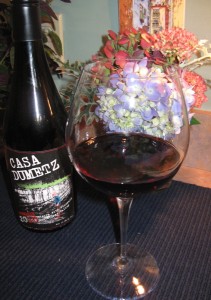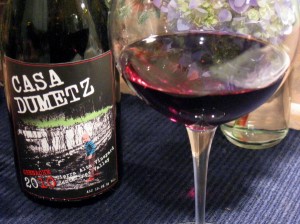Dec 05 2012
Friends, Family and Love for Grenache
People are passionate about wine. They are even more passionate about red wine. There is something luxurious, rich, warm and deep that unfolds from a glass of good red wine. Too often we focus on standard red grapes such as Cabernet Sauvignon, Merlot, Pinot Noir and Zinfandel. There are, however, other varietals in the wine world that when made well create a bottle of red wine equally worthy of the lore shared by its counterparts. Grenache, while often a blending grape, is one such varietal.
Grenache is an often overlooked Spanish grape in the United States. The grape is originally believed to hail from Northern Spain (Aragon, specifically) and up until the 20th century, Spain was its largest producer in the world. Still produced today, however, Grenache generally finds its home as a blending grape and is commonly introduced with Tempranillo (a grape that most readily associate with Spanish wine). Despite its fruit-forward nature, depending on where the grape is grown and the method used to produce its wine, Grenache can still serve as a good rustic red Spanish wine.
While Napa Valley is a proverbial Eden for most wine grapes, Grenache prefers hot dry soils. As you venture south down the 101 in California, you start to descend into a region where this grape can potentially find ideal growing conditions. While it buds early, it needs a long growing season and the valleys adjacent to central coastal California provide just that.
Grenache responds best to a long, slow fermentation at cooler temperatures followed by a maceration period. To guard against oxidation (which is a risk when making Grenache), the wine should be racked minimally. Using new oak barrels helps with retaining color and preventing oxidation, however, too much oak influence can quickly cover up the fruit-forward nature of Grenache and produce an imbalanced wine.
If by now you are creating a mental checklist on how to pick a great Grenache, consider all of those elements met once introduced to Casa Dumetz’s 2010 Gravitas Grenache.
While Emilio Estevez and Sonja Magdevski of Casa Dumetz grow only Pinot Noir vines in their Malibu yard (see “Drink Local, Eat Local” published in April, 2011, on this site), Sonja Magdevski is a savvy vintner and knows best where to source other varietals for their winemaking. Establishing a relationship with the Tierra Alta Vineyard in Santa Ynez Valley, Sonja knows that she is guaranteed to procure quality juicy fruit from a unique steep vineyard in the Ballard Canyon. This vineyard in particular is special for its location but it is also uniquely fit for growing terrific Grenache grapes. While the sourcing of grapes can run a risk of shortage, the owners of the vineyard are growers only and do not make wine. Barring a disastrous growing season, there should be plenty of fruit to go around to adventurous vintners. This also allows the opportunity for vintners to establish a committed relationship to the grapes that they wish to bottle.
Tierra Alta Vineyard was originally planted in the year 2000. Given that the vineyard is relatively young, the vines are presently going to produce juicier, fruit-forward grapes for wine. Couple in the climate of this area of the Santa Ynez Valley with the vineyard’s physical location and a long growing season with slow ripening is ensured. This not only enhances the development of flavors in the grape (which transition into the final bottled wine) but it is particularly ideal for the Grenache grape.
I first had the opportunity to try Casa Dumetz’ 2010 Gravitas Grenache during the summer while visiting with Sonja. With a simple sip, it was readily apparent that there was something special to this bottling (consisting of 85% Grenache and 15% Syrah). The label is equally unique as it features a 1969 childhood photo of Emilio among the vines of his grandfather’s property in Galicia, Spain. The photo was taken by Emilio’s father Ramon Gerard Estevez (Martin Sheen) and it captures Emilio’s soulful child face predestined to a future among the vines and growing grapes. Taking a bottle with me, I elected to save it to share with my brother who had yet to see the movie, “The Way” which was written and directed by Emilio Estevez. While I normally pair food with wine (and planned to with this bottle), pairing it with Emilio’s movie was paramount.
For those unfamiliar, “The Way” is a beautiful movie which was filmed in Northern Spain along El Camino de Santiago. The film stars Martin Sheen as Tom, a crusty set-in-his-ways American doctor who, upon dealing with the tragic loss of his son in France, decides to continue the historical pilgrimage along El Camino to honor his deceased son’s wishes. The greater message of the film is that we do not choose a life, but we live a life and the profound implications that realization can have on oneself. It is a film that artfully captures that life is bigger than that which we perceive on a daily basis and awakens one’s spirit.
As the film got underway, soon we were surrounded by beautiful views of the countryside and towns in Northern Spain and it was only appropriate to pour some of the 2010 Gravitas Grenache.
Housed in a bottle adorned with a screw cap, the wine’s rich bouquet is better preserved. There is no question about this as the wine’s aromas are big and jammy with a notable distinct personality that can be detected one foot away from the wine glass. Big aromas of red raspberries, kissed by the sun, tease of a degree of sweetness in the 2010 Gravitas Grenache. On the palate, the wine is amazingly smooth for a 2010 vintage. It is soft, supple, slightly earthy, spiced, notably rustic and most importantly, the 2010 Gravitas Grenache is utterly delicious. The Grenache is outstanding and it romanticizes the best attributes of artisanal Spanish wine. Seductive, warm rich flavors of red raspberry pour over the palate sweetened with subtle hints of toffee and dressed with warm elements of smoke and clove spice. The wine delivers a full sense of character and is resilient with a clear sense of pride.
While 2010 was a notably challenged harvest for Northern California, Central Coast California shared none of that burdened season. Let me ring the bell loud and clear, good red 2010 vintage wines do come out of California. Simply venture to Santa Ynez Valley or San Luis Obispo County.
It would not be an article on this site if there was not food involved with the pairing of wine. To keep in line with the Spanish theme, I elected to serve some quick simple “pintxos” (which are similar to tapas, however, are served in Basque, Spain, and are simpler by nature). Serving in a series of courses throughout the movie, the following were wonderful.
First, a course of steamed clams with herbs:
Second, a course of small fried Ibiza cheese filled rice balls with a crude garlic tomato tapenade:
Third, Spanish cuisine is not complete with olives, chorizo and cheese. A chorizo selection of salchichon salami, jamon Serrano, and chorizo cantimpalo represented the meats. Iberico, Cabra al Vino and Manchego represented the cheeses. Bits of cantaloupe and fresh chive dressed the plate as palate cleansers:
As the pinchos and the film finished, the wine that was left in the glass fell back across the palate like little bits of dessert. A palate that has been enriched with the spices and flavors of Spanish cuisine will naturally find its final course of sweetness in the bits of Grenache wine that remained. Hints of milk chocolate coupled with soft, subtle notes of vanilla coated the palate with the 2010 Gravitas Grenache’s finish.
This is a romantic wine that whisks you away and transports your senses. It is more than evident that this is a wine that you instinctively wish to share with family, the closest of friends, around a table with food and mostly, with love.
Comments Off on Friends, Family and Love for Grenache






